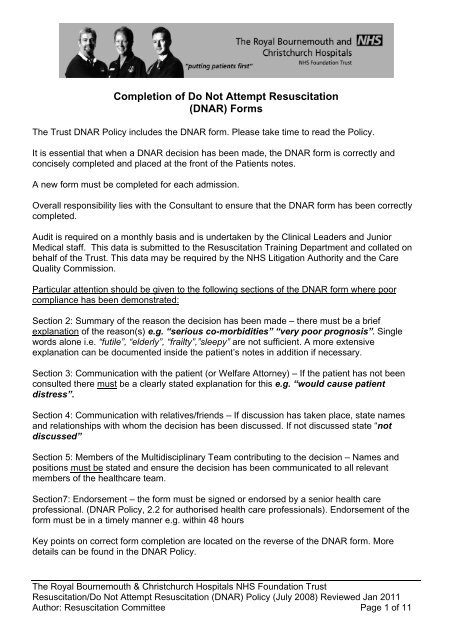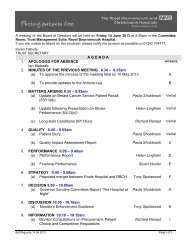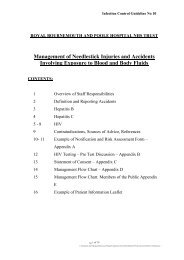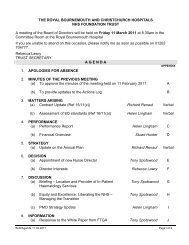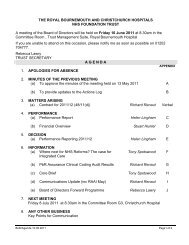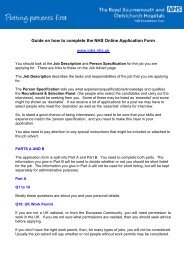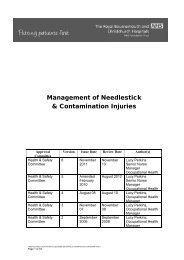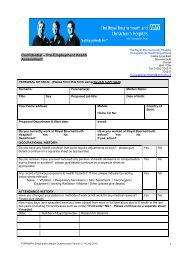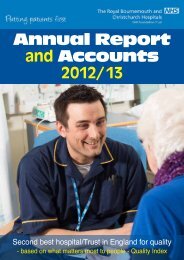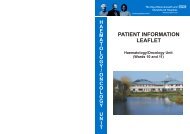Resuscitation Policy (DNAR) July 12 - Royal Bournemouth Hospital
Resuscitation Policy (DNAR) July 12 - Royal Bournemouth Hospital
Resuscitation Policy (DNAR) July 12 - Royal Bournemouth Hospital
- No tags were found...
You also want an ePaper? Increase the reach of your titles
YUMPU automatically turns print PDFs into web optimized ePapers that Google loves.
1.0 IntroductionThis policy has been formulated by the <strong>Resuscitation</strong> Committee of the Trust and agreedby the Trust Management Board. This policy must be adhered to by the medical andnursing staff of the Trust. It has been written for adult patients and is based on the jointstatement from the British Medical Association, the <strong>Resuscitation</strong> Council (UK) and the<strong>Royal</strong> College of Nursing published in October 2007. In the case of patients under theage of 18 a refusal of a CPR (Cardio Pulmonary <strong>Resuscitation</strong>) attempt should be takeninto account, but could be overruled by a court or a person with parental responsibility.<strong>DNAR</strong> (Do Not Attempt <strong>Resuscitation</strong>) decisions apply only to CPR and not to any otheraspects of treatment.2.0 How the Decision is MadeRefer to the Decision-Making Framework (Appendix 1, <strong>DNAR</strong> policy)2.1 Patients for CPRAll patients admitted to the Trust will be for attempted resuscitation unless anactive decision is made to the contrary. Decisions about CPR must be made onthe basis of an individual assessment of each patient’s case. When a <strong>DNAR</strong>decision has not been made or there is uncertainty regarding <strong>DNAR</strong> status, thenresuscitation should be attempted. If appropriate, enquiry should be made at thetime of in-patient admission as to whether a valid and applicable advance decisionexists.It is not necessary to initiate discussion about CPR with a patient if there is noreason to believe the patient is likely to suffer a cardio-respiratory arrest. Theremay be situations in which CPR is commenced, but during attempted resuscitationfurther information comes to light that makes continued CPR inappropriate (forexample, a <strong>DNAR</strong> order, a valid and applicable advance decision, or importantclinical information). In such circumstances, continued attempted resuscitationwould not be appropriate.2.2 Patients not for CPRIf the clinical team believes that CPR would not restart the heart and breathing, itshould not be attempted. The patient’s individual circumstances and the most upto-dateguidance must be carefully considered before such a decision is made.The overall responsibility for a <strong>DNAR</strong> decision rests with the consultant in chargeof the patient’s care. In the absence of the consultant a senior member of theteam possessing the MRCP, MRCS or FRCA or its equivalent, may make a <strong>DNAR</strong>decision. Out of hours, in the absence of a senior doctor, the doctor on call mayundertake the decision in consultation with the consultant on call and nursing staff.In all cases where the consultant in charge has not been involved in the <strong>DNAR</strong>decision, then his/her agreement should be obtained at the earliest opportunity.The decision of <strong>DNAR</strong> status should not preclude undertaking other aspects ofcare.The <strong>Royal</strong> <strong>Bournemouth</strong> & Christchurch <strong>Hospital</strong>s NHS Foundation Trust<strong>Resuscitation</strong>/Do Not Attempt <strong>Resuscitation</strong> (<strong>DNAR</strong>) <strong>Policy</strong> (<strong>July</strong> 2008) Reviewed Jan 2011Author: <strong>Resuscitation</strong> Committee Page 4 of 11
The date and time of giving a <strong>DNAR</strong> decision should be clear and fullydocumented using the <strong>Resuscitation</strong> Order Form (Appendix 2, <strong>DNAR</strong> policy)together with the clinical justification and when applicable, the documenteddiscussion with the patient. The reasons and circumstances of any <strong>DNAR</strong> decisionmust be reviewed regularly on the junior staff and consultant ward rounds. This isessential if there is a material change in the patient’s clinical condition. Anychanges must be fully documented. The nursing staff are encouraged andexpected to raise the issue of resuscitation status of a patient with the medicalteam at these rounds or at other times when appropriate. The resuscitation statusmust be communicated at each patient handover. Importance is placed oncommunication of the resuscitation status to any personnel involved with theclinical management of the patient, e.g. radiographers, physiotherapists etc.When a clinical decision is made that CPR should not be attempted, because itwill not be successful, and the patient has not expressed a wish to discuss CPR, itis not necessary or appropriate to initiate discussion with the patient to exploretheir wishes regarding CPR. However, this decision must be the right one for thepatient. In some circumstances it may be best to explain such a decision to apatient rather than them finding out by chance that a decision has been madewithout them being involved or being informed of it.Uncommonly, some patients for whom a <strong>DNAR</strong> decision has been establishedmay develop cardiac or respiratory arrest from a readily reversible cause such aschoking, induction of anaesthesia, anaphylaxis or blocked tracheostomy tube. Insuch situations CPR would be appropriate, whilst the reversible cause is treated,unless the patient has specifically refused intervention in these circumstances. Inaddition to reversible causes, it may be appropriate to temporarily suspend adecision not to attempt CPR during some procedures if the procedure itself couldprecipitate a cardiopulmonary arrest – for example, cardiac catheterisation,pacemaker insertion or surgical procedure.2.3 Decisions about CPR that are based on the balance of benefits and burdensSome patients do not fall easily into the categories 2.1 and 2.2 above even thoughCPR may be successful in re-starting the patient’s heart and breathing. Then thebenefits of possible prolongation of life must be weighed against the potentialburdens to the patient. This is not solely a clinical decision and in this situation thepatient’s informed views are of paramount importance. The views of members ofthe medical and nursing team involved in the patient’s care are also valuable informing a decision.2.4 Communication and discussion with patients who lack capacity or those closeto patientsIf a patient lacks capacity, any previously expressed wishes must be taken intoaccount when making a CPR decision.Consideration of whether the benefits of attempting CPR would outweigh the risksand burdens for the patient should be discussed by the healthcare team, andthose close to or representing the patient. Such considerations should always beThe <strong>Royal</strong> <strong>Bournemouth</strong> & Christchurch <strong>Hospital</strong>s NHS Foundation Trust<strong>Resuscitation</strong>/Do Not Attempt <strong>Resuscitation</strong> (<strong>DNAR</strong>) <strong>Policy</strong> (<strong>July</strong> 2008) Reviewed Jan 2011Author: <strong>Resuscitation</strong> Committee Page 5 of 11
Therefore if CPR may be able to restart the heart and breathing, and a decision onwhether or not to attempt CPR is based on the balance of benefits and burdens,the Attorney’s decision must be sought.Healthcare professionals should take all practical and appropriate steps toascertain whether a patient: Has made an advance decision to refuse treatment, or, Has appointed a welfare attorney under a Lasting Power of Attorney.If the decision being made by the Attorney does not appear to be in the patient’sbest interests, then it may be necessary to apply to the Court of Protection fordeclaration as to the patient’s best interests.2.7 Adults who lack capacity and have no family, friends or other advocate whom itis appropriate to consult3.0 Date for ReviewAn Independent Mental Capacity Advocate (IMCA) needs to be consulted aboutdecisions concerning ‘serious medical treatment’ where patients have nobody tospeak on their behalf, if ‘what is proposed would be likely to involve seriousmedical consequences for the patient’. Therefore an IMCA does not need to becalled if it is clear to the medical team that CPR would not restart the patient’sheart and breathing.However, if there is genuine doubt about whether or not CPR would have arealistic chance of success, or if a <strong>DNAR</strong> decision is being considered on thebalance of benefits and burdens, an IMCA must be involved. If an urgent decisionis needed (e.g. at night or at a weekend) the decision should be made andrecorded in the health record, and the decision discussed with an IMCA at the firstavailable opportunity.The policy will be reviewed on an annual basis or in response to new national guidance.4.0 ReferencesDecisions relating to cardiopulmonary resuscitationA joint statement from the British Medical Association, the <strong>Resuscitation</strong> Council(UK) and the <strong>Royal</strong> College of NursingOctober 2007 Mental Capacity Act 2005: Code of Practice London:TSO 2007The <strong>Royal</strong> <strong>Bournemouth</strong> & Christchurch <strong>Hospital</strong>s NHS Foundation Trust<strong>Resuscitation</strong>/Do Not Attempt <strong>Resuscitation</strong> (<strong>DNAR</strong>) <strong>Policy</strong> (<strong>July</strong> 2008) Reviewed Jan 2011Author: <strong>Resuscitation</strong> Committee Page 7 of 11
Appendix 1Is cardiac or respiratoryarrest a clear possibilityin the circumstances ofthe patient?NOIf there is no reason to believe that the patient is likely tohave a cardiac or respiratory arrest it is not necessary toinitiate discussion with the patient (or those close to patientswho lack capacity) about CPR. If, however, the patient wishesto discuss CPR this should be respected.YESIs there a realisticchance that CPR couldbe successful?YESNOWhen a decision not to attempt CPR is made on these clearclinical grounds, it is not appropriate to ask the patient’swishes about CPR, but careful consideration should be givenas to whether to inform the patient of the <strong>DNAR</strong> decision(see section 6.)Where the patient lacks capacity and has a welfare attorneyor court-appointed deputy or guardian, this person should beinformed of the decision not to attempt CPR and the reasonsfor it as part of the ongoing discussion about the patient’scare (see section 6).If a second opinion is requested, this request should berespected, whenever possible.Does the patient lackcapacity and have anadvance decisionrefusing CPR or awelfare attorney withrelevant authority?YESIf a patient has made an advance decision refusing CPR, andthe criteria for applicability and validity are met, and the advancedecision meets the documentation requirements stipulated in theMental Capacity Act, this must be respected. If an attorney,deputy or guardian has been appointed they should be consulted(see sections 8 and 9).NOAre the potential risksand burdens of CPRconsidered to begreater than the likelybenefits of CPR?YESWhen there is only a very small chance of success, and thereare questions about whether the burdens outweigh thebenefits of attempting CPR, the involvement of the patient(or, if the patient lacks mental capacity, those close to thepatient) in making the decision is crucial. When the patientis a child or young person, those with parental responsibilityshould be involved in the decision where appropriate. Whenadult patients have mental capacity their own view shouldguide decision-making (see section 7).NOCPR should be attempted unlessthe patient has capacity andstates that they would not wantCPR attempted.ooooDecisions about CPR are sensitive and complex and should be undertaken by experienced membersof the healthcare team and documented carefullyDecisions should be reviewed regularly and when circumstances changeAdvice should be sought if there is uncertainty.Flow chart adapted from the Decision-Making Framework published by the BMA.The <strong>Royal</strong> <strong>Bournemouth</strong> & Christchurch <strong>Hospital</strong>s NHS Foundation Trust<strong>Resuscitation</strong>/Do Not Attempt <strong>Resuscitation</strong> (<strong>DNAR</strong>) <strong>Policy</strong> (<strong>July</strong> 2008) Reviewed Jan 2011Author: <strong>Resuscitation</strong> Committee Page 8 of 11
<strong>Royal</strong> <strong>Bournemouth</strong> & Christchurch <strong>Hospital</strong>s NHS Foundation TrustDO NOT ATTEMPT CARDIOPULMONARY RESUSCITATIONAdults aged 16 years and overNameAddressDate of birthNHS or hospital numberDate of <strong>DNAR</strong> order:/ /DO NOT PHOTOCOPYIn the event of cardiac or respiratory arrest no attempts at cardiopulmonary resuscitation (CPR)will be made. All other appropriate treatment and care will be provided.1 Does the patient have capacity to make and communicate decisions about CPR?If “YES” go to box 2YES / NOIf “NO”, are you aware of a valid advance decision refusing CPR which is relevant tothe current condition?” If “YES” go to box 6If “NO”, has the patient appointed a Welfare Attorney to make decisions on their behalf?If “YES” they must be consulted.YES / NOYES / NOAll other decisions must be made in the patient’s best interests and comply with current law.Go to box 22Summary of the main clinical problems and reasons why CPR would be inappropriate,unsuccessful or not in the patient’s best interests:3Summary of communication with patient (or Welfare Attorney). If this decision has notbeen discussed with the patient or Welfare Attorney state the reason why:4Summary of communication with patient’s relatives or friends:5Names of members of multidisciplinary team contributing to this decision:6Healthcare professional completing this <strong>DNAR</strong> order:NamePositionSignature Date Time7Review and endorsement by most senior health professional:Signature Name DateReview date (if appropriate)Signature Name DateSignature Name Date
This form should be completed legibly in black ball point inkAll sections should be completedThe patient’s full name, date of birth and address should be written clearly.The date of writing the order should be entered.This order will be regarded as “INDEFINITE” unless it is clearly cancelled or a definite review date isspecified.The order should be reviewed whenever clinically appropriate or whenever the patient is transferred from onehealthcare institution to another, admitted from home or discharged home.If the decision is cancelled the form should be crossed through with 2 diagonal lines in black ball-point inkand “CANCELLED” written clearly between them, signed and dated by the healthcare professional cancellingthe order.1. Capacity / advance decisionsRecord the assessment of capacity in the clinical notes. Ensure that any advance decision is valid for thepatient’s current circumstances.16 and 17-year-olds: Whilst 16 and 17-year-olds with capacity are treated as adults for the purposes of consent, parental responsibility willcontinue until they reach age 18. Legal advice should be sought in the event of disagreements on this issue between a young person of 16 or 17and those holding parental responsibility.2. Summary of the main clinical problems and reasons why CPR would beinappropriate, unsuccessful or not in the patient’s best interestsBe as specific as possible.3. Summary of communication with patient…State clearly what was discussed and agreed. If this decision was not discussed with the patient state the reason whythis was inappropriate.4. Summary of communication with patient’s relatives or friendsIf the patient does not have capacity their relatives or friends must be consulted and may be able to help by indicatingwhat the patient would decide if able to do so. If the patient has made a Lasting Power of Attorney, appointing aWelfare Attorney to make decisions on their behalf, that person must be consulted. A Welfare Attorney may be able torefuse life-sustaining treatment on behalf of the patient if this power is included in the original Lasting Power of Attorney.If the patient has capacity ensure that discussion with others does not breach confidentiality.State the names and relationships of relatives or friends or other representatives with whom this decision has beendiscussed. More detailed description of such discussion should be recorded in the clinical notes where appropriate.5. Members of multidisciplinary team…State names and positions. Ensure that the <strong>DNAR</strong> order has been communicatedto all relevant members of the healthcare team.6. Healthcare professional completing this <strong>DNAR</strong> orderThis will vary according to circumstances and local arrangements. In general this should be the most senior healthcareprofessional immediately available.7. Endorsement / review…The decision must be endorsed by the most senior healthcare professional responsible for the patient’s care at theearliest opportunity. Further endorsement should be signed whenever the decision is reviewed. A fixed review date isnot recommended. Review should occur whenever circumstances change.REINSTATEMENT OF A <strong>DNAR</strong>: if this situation were to arise then a new form should be used.<strong>Royal</strong> <strong>Bournemouth</strong> & Christchurch <strong>Hospital</strong>s NHS Foundation Trust.


